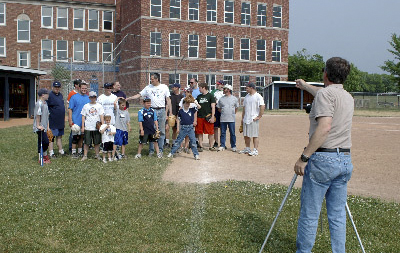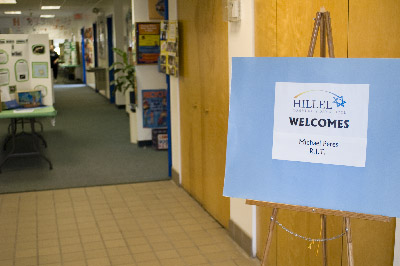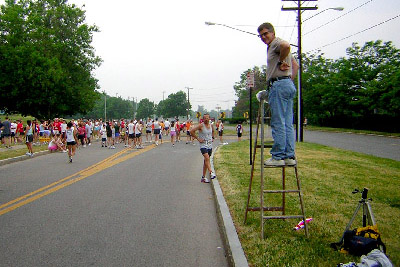in collaboration with the Jewish Community Center of Greater Rochester, New York
Introduction
| During the fall of 2005, I visited the United States Holocaust Museum. It was a very moving experience and during the weeks following the trip, images from one of the galleries [the Tower of Faces] kept coming to mind. In that gallery are photographs produced by Uri Katz a professional photographer from Lithuania. Mr. Katz, his wife and 2 assistants lived and photographed there for many years before the Holocaust. The Tower of Faces gallery is filled with pictures representing their life's work. It is a permanent installation at the Museum - and although I did not count them - there seemed to be hundreds of portraits and family photographs. I found the images and experience very powerful. The experience inspired me to think about photographing all the Jews in Rocheste New York. In the summer of 2005, I also photographed photographs and items from the JCC's archives for the book, the Future begins with the Past. It is interesting to share that fundamental to all societies is the premise that a photograph ascribes a degree of importance to a person or event. This is certainly true for all those who appear in these and other photos. My basic objective for the project was to leave a collection of images chronicling today's Jewish residents. |

| I have been actively making
photographs in for more than 30 years. I work mainly in scientific photography, the
purpose of a science picture is to make a semi-permanent record of a scientific endeavor
in a way that describes an empirical fact without feeling or emotion. In personal
photography the goal is quite the opposite. This exhibition was created to chronicle
and archive Jews in our community in 2007. It is my hope that these photographs will serve
to generate emotions and memories for generations to come about Jewish community
life in Rochester in 2007. When I discussed the concept of photographing as many Rochester Jews as possible, many felt that this was a monumental endeavor and probably to complicated to achieve. I continued to pursue the idea and mentioned it to Leslie Berkowitz, executive director of the JCC. She was intrigued, excited and believed that we could make it happen. In September 2006, with the support of the JCC the Project began. Although I am not particularly religious, being Jewish is important to me. I was raised Jewish, I married a Jewish girl and my children were raised Jewish. When I moved to Rochester in 1986, we joined a temple but that was the really the extent of my awareness of Jewish Rochester. As this project unfolded, I was amazed by the number of Jewish organizations that call Rochester home and the very rich tapestry they create in the community. The opportunity and responsibility to photograph these groups in interesting and appropriate ways was exciting and challenging. Although I was unable to photograph every single Jew in Rochester, I believe that this exhibit serves as a very good representation of the 2007 community. My vision was to create of a representative body of photography that captured and preserved The Faces of Jewish Rochester and I believe there is some measure of success in reaching that objective. The photographs in this exhibit represent my interpretation of what I felt when I photographed in each location with each group. In many cases the groups assembled to take the photograph rather spontaneously. Although each picture is staged there was no forced structure in each photo as the group formed itself. In this fashion, it allowed me to capture the “people and their spirits”, which were exposed to me for just a very few moments. I wanted to include - where possible - the buildings and locations that are used for meetings and gatherings. Often I had very limited time to make pictures and conditions were less than ideal. Weather, time of day, composition, lens choice, and lighting all happened without too much choreography. This project has been one of personal curiosity and learning. I was almost sure I could not photograph 22,500 people but I was also certain I would make many photographs of numerous [largely unknown to me] groups. I was inspired by the challenge of creating a visual legacy. After making the photographs and preparing for the exhibition, I decided to make black and white prints as a strategy to emphasize the people. By creating grayscale photographs the volume of colors and patterns in the 81 photographs was minimized. In closing I would like to acknowledge those who made this project a reality. First and foremost would be my dear friend Leslie Berkowitz for her unbridled enthusiasm and trust. It has been a source of inspiration during the very slow journey of producing this work. Had she not embraced the idea, the photographs would never have been made. A special thank you to Phyllis Kasdin who has worked at the JCC for more than 33 years. Phyllis seems to know everyone and was instrumental in opening dialogues for me using her connections. Risa and Warren Frankel served as volunteer chair people for this project. I thank them for their support and dedication to help make it happen. Other volunteers who were so helpful was Judy Ertishek and Merle Marcus. They were instrumental in reaching out to groups to arrange appointments for photography sessions and helped to open many doors for me. As this adventure comes to an end, I am extremely pleased that I was able to photograph more than 80 groups, which includes (by my rough estimation) more than 5000 people. I feel very fortunate to have a career that takes me on this kind off adventure. Doing this type of work would not be possible without the complete love and support of my wife Laurie and my children, Jonathan and Leah. Their ever present interest in my projects gives me the courage to try new things and be creative when I am tired. Last but certainly not least I want to express my heartfelt appreciation to all of the organizations that participated because without their assistance and full cooperation, no photographs could have been made. I hope they are pleased with how I photographed them. They themselves created the content for this project and I simply interpreted them in places that made sense. Michael Peres October 2007 |


